Kerala - Cochin (Kochi)
Cochin lies within the modern state of Kerala formed on 1 November 1956 by the States Reorganisation Act by combining various Malayalam-speaking regions of southern India.
The region has a long history of trade with the west, particularly in pepper. Arab traders replaced the Persian and Romans and brought Islam to the region.
Like Goa, Kerala fell under Portuguese influence in the 15th century.
With the war between the newly Protestant Dutch Republic and Catholic Spain in 1580, the Portuguese Empire too became fair game for Dutch as well as British military excursions.
Dutch merchants began to enter the intercontinental spice trade by taking over the Portuguese interests, in India, Malaya and particularly present day Indonesia; that became the Dutch East Indies.
The British had formed their East India trading company under Royal Charter from Queen Elizabeth I in 1600 and the Dutch East India Company was founded two years later. The French, who had been cut out of the World dividing deal with the Pope, had similar interests.
Unlike the Portuguese who were on a mission from God to convert heathens, these trading companies were principally interested in making money for their investors. They allowed competing religions to coexist; provided it did not lead to conflict. Above all they wanted stable trading relations and generally acted to put down decent.
By 1753 the Portuguese had been in more or less continuous cultural conflict with the locals for 200 years so the Dutch East India Company found little difficulty in negotiating a treaty with local regent to take their place. But within 50 years, as a result of the Anglo-Mysore Wars, the local regent was overthrown and the territory fell to the British.
Thus there remains a Dutch graveyard at Fort Cochin and a church that changed denomination several times that may be the oldest Christian church in India.
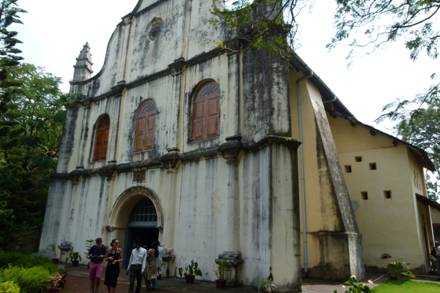
Socially Cochin is like Goa only more so. Kerala prides itself in universal education and the highest literacy rate in India. There are more women than men here and girls are equally well educated. It has a low fertility rate, comparable with a first world country.
It also seems that Kerala has a higher proportion of practicing Christians than any other region in India. These share the religious space with Muslims the Hindu majority.
The three religions live more or less harmoniously together. Just over half are Hindu; about a quarter Sunni Muslim; and most of the remainder Christian. They each have their own part of town so the Muslims and Christians can butcher their beef and perpetrate things anathema to Hindus.
Judging by churches and shrines there seems to be a majority of Christians in the surrounding countryside.
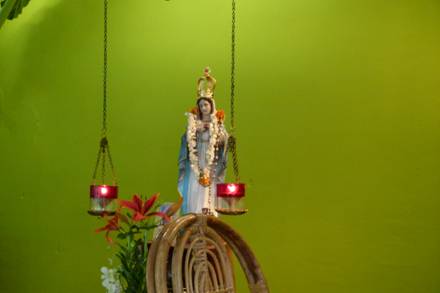
At the moment a lot of goats are in town in preparation for a coming festival. Unfortunately for the goats almost everyone in town is happy to eat them.
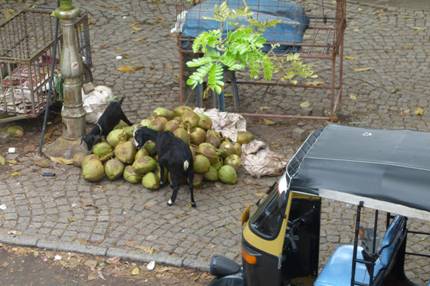
There were once a lot of Jews in the region - who would probably have been into slaughtering fatted goats; or lambs, too.
Cochin reportedly had a Jewish population as long ago as 587 BCE but certainly had a reliably documented Jewish presence in 70 CE; one of the oldest outside Europe and the Middle East. But the Zionists turned up in the 40's and all except nine, yes nine - count them, left for Israel. These remaining nine maintain the exceptionally historic synagogue. A similar thing happened in Calcutta.
We had the services of a Tuck-tuck driver with good English (Salim) he is Muslim. At one point he rushed off to prayers. On returning he said: ‘I feel good I have God in my heart again’. It was charming. It's hard to think that Islam is any worse than any other religion when practiced like that.
People like him are let down by the extremists who murder schoolgirls.
Just as Christianity is let down by mass murderers in the US and Norway; those who oppose another women’s right to manage her own fertility; or those who kill each other in Ireland over ludicrous differences (like the authority of the Bishop of Rome, transubstantiation or what constitutes a sacrament); and Hindus are let down by those who murder around a thousand girls a year over inter-cast relationships.
Unlike Goa, here there are lots of data cables strung about. But still the power fails and the standby generators kick-in. As in many places in India this is a real problem for further industrialisation.
Although the much vaunted women's rights are an improvement; for example girls and boys play sport together at school until well into their teens, women still have a separate section on some ferries. Others are mixed – presumably you catch the one that fails to offend. On the mixed ones we even saw young, and some quite old, local couples with arms about each other; in public. Boats of shame!
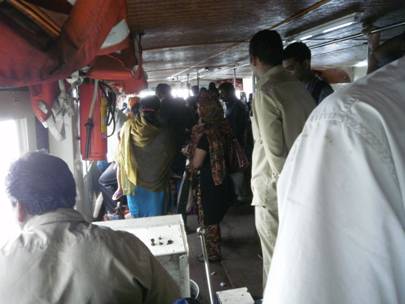
Men still predominate at festivals; even at Christmas in Cochin; when according to our tuck-tuck driver men dress up as women and dance in the street and women stay at home. Maybe it’s a Muslim Christmas? We were told that they burn Santa each New Year’s eve to see off the old year and make a new one each year for Christmas. Perhaps Santa is like Guy Fawkes at Hogmanay?
See these Indians can update any tired old religion; no worries. Look what they have done for Hinduism. But unlike Japan they do not yet nail Santa to a cross.
A lot of the young Muslims find work in the Middle East - the UAE and Saudi - they are not treated well there but they make good money. Our driver proudly told us that as a result he has a three bedroom home with en-suite bathrooms. He has just two kids, a girl and a boy; both at Catholic school and expected to go to University. He proudly said that he is a graduate - but possibly from high school. His friend from high school is a sound engineer in Bollywood.
Despite some of the best quality of life indicators in the developing world, the economy still has a strong rural and fishing component.
In several areas along the coastline of the bay Chinese fishing nets are a feature. There were some good examples directly across the park from out hotel. These have a large square net that is lowered on a cantilevered arm supporting spider-like spreaders into the bay. In the right conditions fish are attracted into the water above the net which is then raised. I watched as one rose to reveal a catch of a few fish and some water-weed. But the net catch from many tens of these nets raised and lowered many times must be substantial. The process seems relatively labour efficient but they only operate when the fish are running. Most of the fisher folk seemed to spend a good deal of time sitting around happily repairing nets.
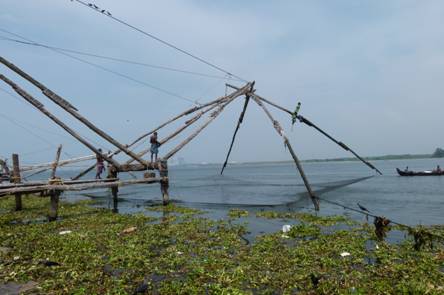
Part of the latest catch was on display at a fish monger adjacent to the nets. The fish here are obviously fresh and surprisingly large and varied. It’s a good place to have fish meals; not a safe option in much of India.
Spices like cinnamon and ginger, but particularly pepper, are still an important export.
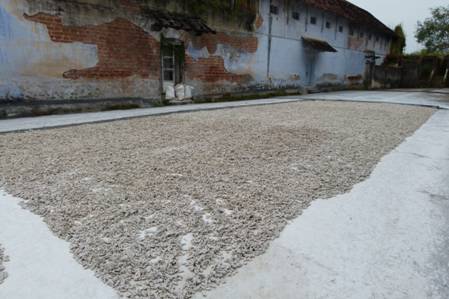
Processing ginger
There is also a major LNG port facility and a substantial shipbuilding industry. The Indian navy has a vast facility in Fort Cochin surrounded by a wall topped with razor wire and there is a ‘special industrial zone’ that supports a range of manufacturing and IT related businesses. In recent years the district has attracted investment in electronics and other advanced industries. Unlike Goa manufacturing contributes substantially more to the local economy than tourism.
Education itself is a big industry; and every second building seems to be some kind of school or college. The high living standards and good education are just beginning to pay off in terms of economic development; possibly in part because it has until recently Kerala has been one of the few freely elected Communist states in the world.
The local free reading room - frequented by old men - features a big mural of Che Guevara. There is a lot of pride in the treatment of the poor and the supposed elimination of cast. Yet the same people seem to do the same jobs.
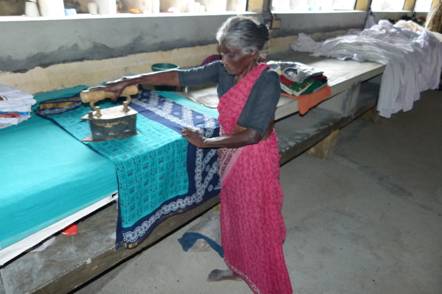
Like everywhere in India while we can breeze in to the best hotels just to use the loo, but guards on many doors turn away much of the local population. This even happens at ordinary looking cafes.
India is one place you don't see McDonalds!
In the better-off areas there is a reasonable coffee chain called Café Coffee Day that can actually make a decent flat white - that they call a latté. It’s a bit of a magnet for Europeans and better-off young Indians. But the poor Cochin manager had one crazy, probably drug addled, European after another to contend with.
First a couple of semi-bearded thirty-something men in baseball caps - one completely off his face – claimed, with slurred speech, that he got the wrong change. No sooner had this been reluctantly resolved, in the shop’s interest, by the emptying of pockets and flattening screwed up notes, than a second couple turned up.
A blond girl, in Indian tourist market cotton, was accompanied by a man with shaven head except for a snaky pattern of sculptured dark hair; and a pierced face to match. They proceeded to engage in a long and voluble dispute about the redemption value of a coffee card they had. The man kept demanding to see someone higher-up; a request the manager obviously had no intention of satisfying. Given their obvious need for petty cash I was dubious that they had actually purchased a coffee card in the first place.
It was like a three ring circus with European druggies as the clowns.
From my travel notes:
We made it to Kerala after the wildest plane ride either of us has ever experienced. We were on a turbo-prop aircraft that obviously was unable to fly above a severe electrical storm. We were flung up and down and side to side, lightening flashing all around. I was surprised how well all the passengers took it. But once on the ground there was audible relief.
Our hotel here is very nice with huge public spaces and verandas.
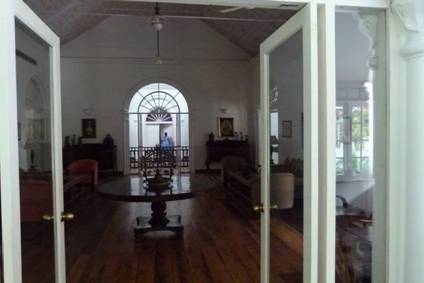
There has just been an enormous tropical downpour and we enjoyed a lovely dinner looking out at the rain. It's around 24 degrees C.
On cue the local grid has just failed again - we are on the hotel's generator again.
Again like Goa, it is hard to believe that this tropical paradise is part of India and not in SE Asia some where else.
The backwaters
We are doing the touristy thing tonight - spending it on a rice boat in the backwaters. These are low lying lands used as rice paddies. They are crossed by a checker board of raised canals each a couple of hundred metres wide. The rice boats are low draft wide beamed boats once used as barges to transport the rice but they are now virtually all converted, with well appointed cabins for tourists. Almost all the tourists are Indians.
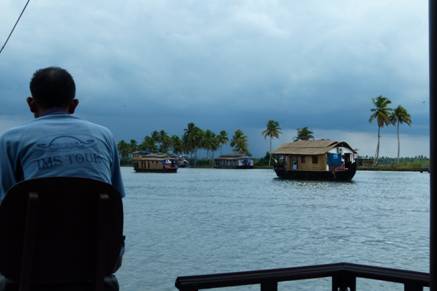
Ours has a single double cabin with en-suite toilet and a crew of two. Many are a lot bigger. The boat itself has a diesel engine somewhere below and a separate 2kVA generator unit on the back deck to provide AC/fans, TV and lights.
The bigger boats have much larger generators. Boat quality varies considerably.
We have been sitting up in our arm chairs, like lord and lady muck being served with food and drinks as we navigate the lake and canals. We brought our own wine with us.
Occasionally we return the waves of other tourists in passing boats. I'm practicing my royal nod and minimal hand movement; wrist held stationary.
It's now raining again and our captain is getting soaked but I'm sitting here nice and dry.
While it is pretty cruising between the coconut and banana trees all laden with fruit, it is a bit repetitive.
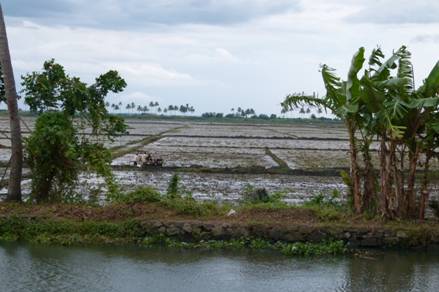
Now there are houses along the banks adding some interest. Interestingly like the paddy fields they seem to be below water level. There would be a very nasty flood if the banks broke; but they seem to be concrete and or stone and quite wide. Less than a meter rise in water level would over-top them so I hope there is some good engineering somewhere to ensure this doesn't happen. There's an awful lot of water in these canals and lakes.
Monday
The night was difficult. The AC was too cold and there was no adjustment. Turning it off made the room into an oven. Opening the doors invited the mosquitoes in. By frequent changes we somehow managed a few hours sleep.
But the morning was splendid cruising back past villages to the base while eating breakfast.
Later we changed hotel to one in the main town nearer the station. The traffic here is dreadful.
The move took an hour, during which our driver at different times, swiped both side mirrors; and quite a bit would have been faster on foot.
To occupy the time until our train at 10:50 pm we walked around the area then got a Tuck-tuck to the ferry terminal; over to a riverside bar. The return trip ran into another tropical downpour.
We retired wet to the hotel; to take a warm shower and apply towels and the hair-drier to the clothes and shoes.
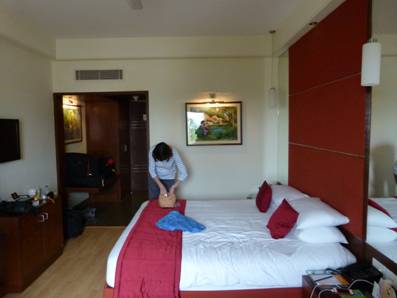
The train
Actually the station was quite civilised compared to northern India. The train was late and we weren't quite sure where our carriage would be - at the end we were told. As the trains are 20 cars long and the stop was 5 min this is important. The journey to Madurai takes 12 hours. There was no 1st sleeper with AC so we booked 2nd - like European couchettes - not particularly comfortable but I got more sleep than on the boat. A tip: book four seats - you get an area like a cabin. But we didn't realise this.
